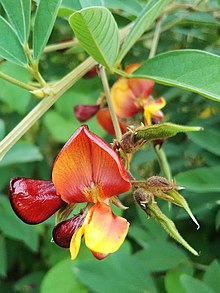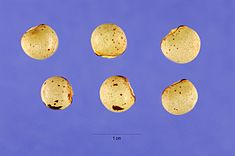
A | B | C | D | E | F | G | H | CH | I | J | K | L | M | N | O | P | Q | R | S | T | U | V | W | X | Y | Z | 0 | 1 | 2 | 3 | 4 | 5 | 6 | 7 | 8 | 9
| Pigeon pea | |
|---|---|

| |
| Botanical illustration of the morphological details of a C. cajan specimen. | |

| |
| Botanical image depicting the foliage characteristics and differing pod and flower phenotypes. | |
| Scientific classification | |
| Kingdom: | Plantae |
| Clade: | Tracheophytes |
| Clade: | Angiosperms |
| Clade: | Eudicots |
| Clade: | Rosids |
| Order: | Fabales |
| Family: | Fabaceae |
| Subfamily: | Faboideae |
| Genus: | Cajanus |
| Species: | C. cajan
|
| Binomial name | |
| Cajanus cajan (L.) Huth
| |
The pigeon pea[1] or toor dal (Cajanus cajan) is a perennial legume from the family Fabaceae native to the Eastern Hemisphere.[2] The pigeon pea is widely cultivated in tropical and semitropical regions around the world, being commonly consumed in South Asia, Southeast Asia, Africa, Latin America and the Caribbean.[3]: 5941
Etymology and other names

Scientific epithet
The scientific name for the genus Cajanus and the species cajan derive from the Malay word katjang (modern spelling: kacang) meaning legume in reference to the bean of the plant.[5]
Common English names
In English they are commonly referred to as pigeon pea which originates from the historical utilization of the pulse as pigeon fodder in Barbados.[6][7] The term Congo pea and Angola pea developed due to the presence of its cultivation in Africa and the association of its utilization with those of African descent.[8][9] The names no-eye pea and red gram both refer to the characteristics of the seed, with no-eye pea in reference to the lack of a hilum blotch on most varieties, unlike the black-eyed pea, and red gram in reference to the red color of most Indian varieties and gram simply referring to the plant being a legume.[10]
Internationally
Africa
This section should specify the language of its non-English content, using {{lang}}, {{transliteration}} for transliterated languages, and {{IPA}} for phonetic transcriptions, with an appropriate ISO 639 code. Wikipedia's multilingual support templates may also be used. (December 2022) |
In Benin the pigeon pea is locally known as klouékoun in Fon, otinin in Ede and eklui in Adja.[11] In Cape Verde they are called Fixon Kongu in Cape Verdean creole.[12] In Comoros and Mauritius they are known as embrevade or ambrebdade in Comorian[13] and Morisyen, respectively, in return originating from the Malagasy term for the plant amberivatry.[14] In Ghana they are known as aduwa or adowa in Dagbani.[15][16] In Kenya and Tanzania they are known as mbaazi in Swahili.[17] In Malawi they are called nandolo in Chichewa.[18] In Nigeria pigeon peas are called fiofio or mgbụmgbụ in Igbo,[19][20] waken-masar "Egyptian bean"[21] or waken-turawa "foreigner bean"[22] in Hausa,[23] and otinli in Yoruba.[24] In Sudan they are known as adaseya, adasy and adasia.[25][26]
Asia
This sub-section needs additional citations for verification. (August 2024) |

In India the plant is known by various different names such as
- Assamese: ৰহৰ মাহ (rohor mah), মিৰি মাহ (miri-mah)
- Bengali: অড়হর (arahar)
- Gujarati: તુવેર (tuver)
- Hindi: अरहर (arhar), तुवर (tuvar)
- Kannada: ತೊಗರಿ ಬೆಳೆ (togari bele), ತೊಗರಿ ಕಾಳು (togari kalu)
- Konkani: तोरी (tori)
- Malayalam: ആഢകി (adhaki), തുവര (tuvara)
- Manipuri: মাইৰোংবী (mairongbi)
- Marathi: तूर (tur)
- Nepali: रहर (rahar)
- Oriya: ହରଡ଼ (harada), କାକ୍ଷୀ (kakhyi), ତୁବର (tubara)
- Punjabi: ਦਿੰਗੇਰ (dinger)
- Tamil: ஆடகி (adhaki), இருப்புலி (iruppuli), காய்ச்சி (kaycci) and துவரை (tuvarai)
- Telugu: కంది (kandi), ఆఢకి (adhaki), తొగరి (togari), తువరము (tuvaramu)[citation needed]
- Tibetan: tu ba ri
- Urdu: ارهر (arhar), توأر (tuar).[27][28]
In Persian,it is known as شاخول (shakhul) and is popular in dishes. In the Philippines they are known as Kadios in Filipino and Kadyos in Tagalog.[29][30]
The Americas
In Latin America,[31] they are known as guandul or gandul in Spanish, and feijão andu or gandu in Portuguese all of which derive from Kikongo wandu or from Kimbundu oanda; both names referring to the same plant.[32][33][34][35]
In the Anglophone regions of the Caribbean, like Jamaica,[36] they are known as Gungo peas, coming from the more archaic English name for the plant congo pea, given to the plant because of its popularity and relation to Sub-Saharan Africa.[37][38]
In Francophone regions of the Caribbean they are known as pois d' angole,[39] pwa di bwa in Antillean creole[40] and pwa kongo in Haitian creole.[41]
In Suriname they are known as wandoe[42] or gele pesi,[43] the former of which is derived from the same source as its Spanish and Portuguese counterparts, the latter of which literally translates to 'yellow pea' from Dutch and Sranan Tongo.
Oceania
In Hawaii they are known as pi pokoliko 'Puerto Rican pea' or pi nunu 'pigeon pea' in the Hawaiian language.[44]
History and origin


Origin
The closest relatives to the cultivated pigeon pea are Cajanus cajanifolia, Cajanus scarabaeoides and Cajanus kerstingii, native to India and the latter West Africa respectively.[45][46][47] Much debate exist over the geographical origin of the species, with some groups claiming origin from the Nile river and Western Africa, and the other Indian origin.[48] The two epicenters of genetic diversity exist in both Africa and India, but India is considered to be its primary center of origin with West Africa being considered a second major center of origin.[49]
History
By at least 2,800 BCE in peninsular India,[50] where its presumptive closest wild relatives Cajanus cajanifolia occurs in tropical deciduous woodlands, its cultivation has been documented.[51] Archaeological finds of pigeon pea cultivation dating to about 14th century BC have also been found at the Neolithic site of Sanganakallu in Bellary and its border area Tuljapur (where the cultivation of African domesticated plants like pearl millet, finger millet, and Lablab have also been uncovered),[52] as well as in Gopalpur and other South Indian states.[53]
From India it may have made its way to North-East Africa via Trans-Oceanic Bronze Age trade that allowed cross-cultural exchange of resources and agricultural products. [54] The earliest evidence of pigeon peas in Africa was found in Ancient Egypt with the presence of seeds in Egyptian tombs dating back to around 2,200 BCE. [55] From eastern Africa, cultivation spread further west and south through the continent, where by means of the Trans-Atlantic slave trade, it reached the Americas around the 17th century.[38]
Pigeon peas were introduced to Hawaii in 1824 by James Macrae with a few specimens becoming naturalized on the islands, but they wouldn't gain much popularity until later.[56] By the early 20th century Filipinos and Puerto Ricans began to emigrate from the American Philippines and Puerto Rico to Hawaii to work in sugarcane plantations in 1906 and 1901, respectively.[57][58][59] Pigeon peas are said to have been popularized on the island by the Puerto Rican community where by the First World War their cultivation began, to expand on the island where they are still cultivated and consumed by locals.[60]
Nutrition
 Pigeon peas in Trinidad and Tobago | |||||||||||||||||||||||||||||||||||||||||||||||||
| Nutritional value per 100 g (3.5 oz) | |||||||||||||||||||||||||||||||||||||||||||||||||
|---|---|---|---|---|---|---|---|---|---|---|---|---|---|---|---|---|---|---|---|---|---|---|---|---|---|---|---|---|---|---|---|---|---|---|---|---|---|---|---|---|---|---|---|---|---|---|---|---|---|
| Energy | 569 kJ (136 kcal) | ||||||||||||||||||||||||||||||||||||||||||||||||
23.88 g | |||||||||||||||||||||||||||||||||||||||||||||||||
| Sugars | 3 g | ||||||||||||||||||||||||||||||||||||||||||||||||
| Dietary fiber | 5.1 g | ||||||||||||||||||||||||||||||||||||||||||||||||
1.64 g | |||||||||||||||||||||||||||||||||||||||||||||||||
7.2 g | |||||||||||||||||||||||||||||||||||||||||||||||||
| |||||||||||||||||||||||||||||||||||||||||||||||||
Link to USDA Database entry Values for Choline, Vit. E/K available | |||||||||||||||||||||||||||||||||||||||||||||||||
| †Percentages estimated using US recommendations for adults,[61] except for potassium, which is estimated based on expert recommendation from the National Academies.[62] | |||||||||||||||||||||||||||||||||||||||||||||||||
 Seeds of the pigeon pea | |||||||||||||||||||||||||||||||||||||||||
| Nutritional value per 100 g (3.5 oz) | |||||||||||||||||||||||||||||||||||||||||
|---|---|---|---|---|---|---|---|---|---|---|---|---|---|---|---|---|---|---|---|---|---|---|---|---|---|---|---|---|---|---|---|---|---|---|---|---|---|---|---|---|---|
| Energy | 1,435 kJ (343 kcal) | ||||||||||||||||||||||||||||||||||||||||
62.78 g | |||||||||||||||||||||||||||||||||||||||||
| Sugars | n/a | ||||||||||||||||||||||||||||||||||||||||
| Dietary fiber | 15 g | ||||||||||||||||||||||||||||||||||||||||
1.49 g | |||||||||||||||||||||||||||||||||||||||||
21.7 g | |||||||||||||||||||||||||||||||||||||||||
| Tryptophan | 212 mg | ||||||||||||||||||||||||||||||||||||||||
| Threonine | 767 mg | ||||||||||||||||||||||||||||||||||||||||
| Isoleucine | 785 mg | ||||||||||||||||||||||||||||||||||||||||
| Leucine | 1549 mg | ||||||||||||||||||||||||||||||||||||||||
| Lysine | 1521 mg | ||||||||||||||||||||||||||||||||||||||||
| Methionine | 243 mg | ||||||||||||||||||||||||||||||||||||||||
| Cystine | 250 mg | ||||||||||||||||||||||||||||||||||||||||
| Phenylalanine | 1858 mg | ||||||||||||||||||||||||||||||||||||||||
| Tyrosine | 538 mg | ||||||||||||||||||||||||||||||||||||||||
| Valine | 937 mg | ||||||||||||||||||||||||||||||||||||||||
| Arginine | 1299 mg | ||||||||||||||||||||||||||||||||||||||||
| Histidine | 774 mg | ||||||||||||||||||||||||||||||||||||||||
| Alanine | 972 mg | ||||||||||||||||||||||||||||||||||||||||
| Aspartic acid | 2146 mg | ||||||||||||||||||||||||||||||||||||||||
| Glutamic acid | 5031 mg | ||||||||||||||||||||||||||||||||||||||||
| Glycine | 802 mg | ||||||||||||||||||||||||||||||||||||||||
| Proline | 955 mg | ||||||||||||||||||||||||||||||||||||||||
| Serine | 1028 mg | ||||||||||||||||||||||||||||||||||||||||
| Hydroxyproline | 0 mg | ||||||||||||||||||||||||||||||||||||||||
| |||||||||||||||||||||||||||||||||||||||||
Link to USDA Database entry Values for Choline, Vit. E/K unavailable | |||||||||||||||||||||||||||||||||||||||||
| †Percentages estimated using US recommendations for adults,[61] except for potassium, which is estimated based on expert recommendation from the National Academies.[62] | |||||||||||||||||||||||||||||||||||||||||
Pigeon peas contain high levels of protein and the important amino acids methionine, lysine, and tryptophan.[63]
The following table indicates completeness of nutritional profile of various amino acids within mature seeds of pigeon pea.
| Essential Amino Acid | Available mg/g of Protein | Min. Required mg/g of Protein |
|---|---|---|
| Tryptophan | 9.76 | 7 |
| Threonine | 32.34 | 27 |
| Isoleucine | 36.17 | 25 |
| Leucine | 71.3 | 55 |
| Lysine | 70.09 | 51 |
| Methionine+Cystine | 22.7 | 25 |
| Phenylalanine+Tyrosine | 110.4 | 47 |
| Valine | 43.1 | 32 |
| Histidine | 35.66 | 18 |
Methionine + Cystine combination is the only limiting amino acid combination in pigeon pea. In contrast to the mature seeds, the immature seeds are generally lower in all nutritional values, however they contain a significant amount of vitamin C (39 mg per 100 g serving) and have a slightly higher fat content. Research has shown that the protein content of the immature seeds is of a higher quality.[64]
